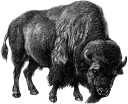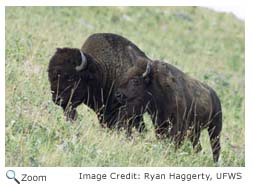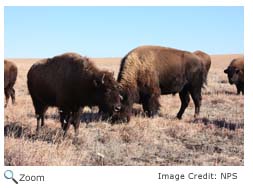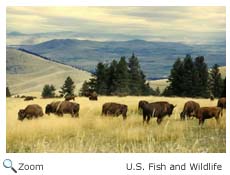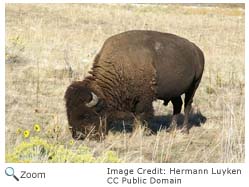American Bison - Bison bison |
|||||||||||
Description Range HabitatThe American bison lives on plains, prairies, and river valleys. Diet
|
Life CycleFemale bison are ready to mate when they are 2-3 years old. Males aren't ready to mate until they are about six. Mating season begins in July and can run through September. When mating season begins, male bison move into female groups and select a female. They then "tend" the female.
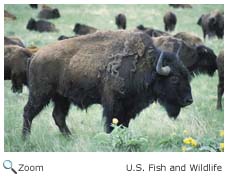 Males tend a female by staying between her and the rest of the herd. Tending can last for a few minutes or for several days. If a female isn't interested in a male, she walks away. Males threaten and sometimes attack other males that try to get too close to a female he is tending. Fights between males can involve head butting, shoving, or locking horns. Males tend a female by staying between her and the rest of the herd. Tending can last for a few minutes or for several days. If a female isn't interested in a male, she walks away. Males threaten and sometimes attack other males that try to get too close to a female he is tending. Fights between males can involve head butting, shoving, or locking horns. 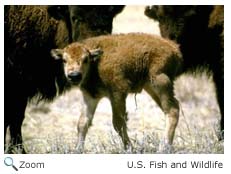 The female gives birth to one calf after about nine months. She goes to an isolated area to give birth. Newborn bison are reddish-brown and stand shortly after birth. The mother and her calf stay isolated from the herd for a couple of days. At about two months, the calf begins to develop shoulder humps and horns. The calf is usually weaned by the time it is seven months old, but it stays with its mother until it is a year old. The American bison lives 15-20 years in the wild. The female gives birth to one calf after about nine months. She goes to an isolated area to give birth. Newborn bison are reddish-brown and stand shortly after birth. The mother and her calf stay isolated from the herd for a couple of days. At about two months, the calf begins to develop shoulder humps and horns. The calf is usually weaned by the time it is seven months old, but it stays with its mother until it is a year old. The American bison lives 15-20 years in the wild. Behavior Bison live in a variety of groups. Females and young males may live in groups of up to 20 bison. Males also live in groups of up to 20 males, or they can live in smaller groups, or they can live alone. Mature males and females usually live apart, except during breeding season. Each bison group has a dominant male or female. |
||||||||||
Audio Credit: National Park Service /Shan Burson |
|||||||||||

